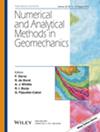Enriched EFG Method for Hydraulic Fracture Modeling in Multiphase Porous Media
Abstract
The numerical investigation in this study focuses on the propagation of hydraulically driven fractures in deformable porous media containing two fluid phases. The fully coupled hydro-mechanical governing equations are discretized and solved using the extended element-free Galerkin method. The wetting fluid is injected into the initial crack. The pores are filled with both wetting and non-wetting fluid phases. Essential boundary conditions are enforced using the penalty method. To model the discontinuities in field variables, the extrinsic enrichment strategy is employed. Ridge and Heaviside enrichment functions are utilized to introduce weak and strong discontinuities, respectively. The nonlinear behavior in front of the crack tip is defined by means of a cohesive crack model. Continuity equations for wetting and non-wetting fluids through the fracture domain are expressed using Darcy's law and cubic law. The coupling terms of fluids are considered in accordance with their mass transfer among the crack and the surrounding domain, simulating the fluid leak-off phenomenon and the fluid lag zone. The results demonstrate the success of the proposed numerical framework in simulating the intricate aspects of the hydraulic fracturing process. Sensitivity analysis is performed with varying domain permeabilities and wetting fluid viscosities to elucidate their effects on different aspects of hydraulic fracture.

 求助内容:
求助内容: 应助结果提醒方式:
应助结果提醒方式:


